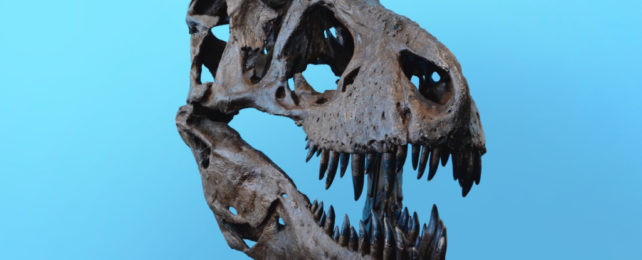A new study suggests Tyrannosaurus rex had the brains to match its brawn.
According to neuroanatomist Suzana Herculano-Houzel, the predatory dinosaurs with tiny arms that are often described as dim-witted dopes might have been as brainy as modern monkeys – or at least had a comparable number of brain cells.
Not all paleontologists are convinced, however. The bold claims are "far-fetched" and based on some questionable interpretations of outdated data, they say.
But there's nothing quite like a scientific controversy to ponder a few big questions about intelligent beings and the electrochemical constellations inside our own heads that we still don't fully understand.
Herculano-Houzel, the sole author of the paper, used data on living birds and modern reptiles to infer how the number of neurons scales with increasing brain mass.
She then extrapolated to predict how many brain cells T. rex might have had in its telencephalon – the more highly developed part of the brain also commonly known as the cerebrum. Consisting of two hemispheres, this chunk of neural anatomy is responsible for the animal's cognition (amongst other stuff).
Herculano-Houzel estimated that T. rex had roughly 3 billion cerebral neurons packed into its 343-gram (12-ounce) brain; more than the number found in baboons. By her calculations, another theropod dinosaur, Alioramus, notched up about 1 billion cerebral neurons in its 73-gram (2.5-ounce) brain, which is on par with a capuchin monkey's.
If those numbers reflected braininess, this "would make these animals not only giant but also long-lived and endowed with flexible cognition, and thus even more magnificent predators than previously thought," Herculano-Houzel, of Vanderbilt University in Nashville, writes in her published paper.
"An elephant-sized but agile carnivoran biped endowed with macaque- or baboon-like cognition must have been an extremely competent predator indeed," she adds.
It's officially news: T. rex had baboon-like numbers of brain neurons, which means it had what it takes to build tools, solve problems, and live up to 40 years, enough to build a culture! Paper is just out in J Comp Neurol. Reality was actually MORE terrifying than the movies! pic.twitter.com/6HafJVHQlk
— Suzana Herculano-Houzel (@suzanahh) January 5, 2023
That's pretty wild, to suggest Tyrannosaurus and other theropod dinosaurs were 'the primates of their times', and it involves making a few assumptions to get there. But it's where Herculano-Houzel goes next that has arguably caused even more of an uproar amongst paleontologists, biologists, and neuroscientists.
Based on her findings and previous studies, Herculano-Houzel predicts T. rex would have matured fast, lived long enough – over 40 years – and had brains capable of using tools and passing that knowledge on to kin.
Their neuron count places Tyrannosaurus and possibly other theropod dinosaurs "in the cognitive realm of tool-using and culture-building modern birds and primates," Herculano-Houzel writes.
Cue much skepticism. "Intelligence itself is already a difficult thing to study, let alone study the intelligence of an extinct taxon that is incapable of having its behavior observed," University of Bristol paleobiologist Tess Gallagher wrote on Twitter.
"Don't get me wrong. T. rex was probably smarter than we give it credit for, but tool use capabilities? That's a very big claim to make."
Another gripe amongst biologists is that skull size does not necessarily equate to brain volume or mass. Herculano-Houzel used brain size estimates based on CT scans of fossilized skulls.
While Herculano-Houzel argues theropod brains filled their cranial cavity, other studies have suggested that the brain of T. rex only occupied between a third to a half of its endocranial space.
Either way, brain folds, wrinkles, and synaptic connections are often considered to be better indicators of intelligence than total brain size or even the number of cells it contains.
Crows, for example, are remarkably intelligent animals with relatively small brains; they have fewer cerebral neurons than baboons yet outperform them on cognitive tasks, says Kai Caspar, a zoologist at the University of Duisburg-Essen in Germany.
"Maybe neuron counts do not make an animal's mind and the connectome also matters?" Caspar tweeted, referring to the web of connections in a given brain.
But bony skulls are preserved, and squishy brains are not, so that's all scientists really have to go by when trying to imagine what dinosaurs were like.
Herculano-Houzel argues that estimating neuron counts from brain mass is a method that has been applied to hundreds of mammal, bird, and non-avian dinosaur species, so it is robust.
But she also notes that doing so turns animal brains "into a homogeneous soup" of floating brain cells that in reality, are structured in layers of tissue.
Tyrannosaurus continues to surprise us, with recent discoveries painting them as social animals with elegant, swishing tails that tended to hunt in packs, not alone, and warred for love. However many neurons their brains had, the tyrant lizards love to keep us thinking.
The study was published in the Journal of Comparative Neurology.
